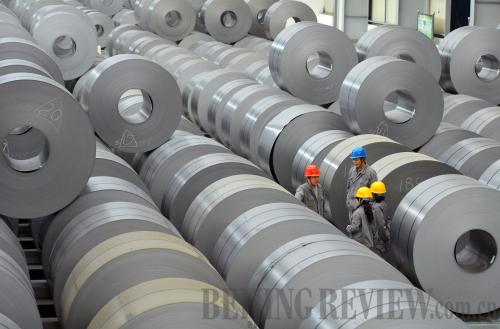|
 |
|
REORGANIZING PRODUCTION: Workers inspect cold-rolled steel plates at Tangshan Iron and Steel Group Co. in Hebei Province (ZHENG YONG) |
China is propelling the reorganization of nine key industries in an effort to ramp up international competition and solve its problem of overcapacity.
The nine key industries are automobile, iron and steel, cement, shipbuilding, electrolytic aluminum, rare earth, electronic information, pharmaceutical and agriculture. On January 22, 12 government ministries, including the Ministry of Industry and Information Technology (MIIT), the National Development and Reform Commission and the Ministry of Finance jointly released guidelines on how to merge and reorganize these industries.
Zhu Hongren, MIIT's chief engineer, says that change in these industries is needed because of, among other things, overcapacity and outdated modes of production. Zhu adds that by encouraging mergers and the reorganization of industries, China can extend its industrial chains and establish major industrial leaders.
Mergers and reorganization should be market initiatives. So why is the government involved?
The MIIT has found that some enterprises have no strategic consideration for mergers and reorganization and did not consider mergers in accordance with their major businesses and core competitiveness. Furthermore, some enterprises were not clearly aware of the risks of merging, encountering unexpected problems. Other mergers failed because of an unsuccessful integration of assets, human resources, management and corporate culture, despite good merger schemes and preliminary risk controls.
Zhu says by issuing the guideline, the government aims to guide enterprises to assess merger risks, while believing that mergers and reorganization should be market-oriented.
The government's role in corporate mergers and reorganization includes two aspects: First, to sort out, revise and annul policies and measures unfavorable to mergers and reorganization, particularly to annul measures issued by local governments restricting mergers of local enterprises.
Second, to offer suggestions guiding enterprises to create reasonable reorganization plans by considering their own plans, national policies and macroeconomic conditions.
Automobile, iron and steel, cement and electrolytic aluminum industries have all seen vicious price competition caused by overcapacity, which harms the development of these industries.
In 2010 the State Council issued a series of policies promoting corporate mergers and reorganization. After that, the outline for the 12th Five-Year Plan (2011-15) and other long-term national development plans have proposed to advance mergers and reorganization in the automobile, iron and steel and cement industries.
A report by BOC International (China) Ltd. states that under the background of economic transition, promoting corporate mergers and reorganization will be an important step in advancing industrial upgrading and accelerating the transformation of the country's economic growth pattern. It is imperative that China improves efficiency in terms of resource allocation and nurtures large companies to build international competitiveness.
There are more than 300 listed companies among the nine industries, and the new guidelines have a significant impact on China's capital markets. China Securities Co. Ltd., BOC International (China) Ltd, and some other investment institutions believe that the new guidelines will lead to a variety of results.
| 